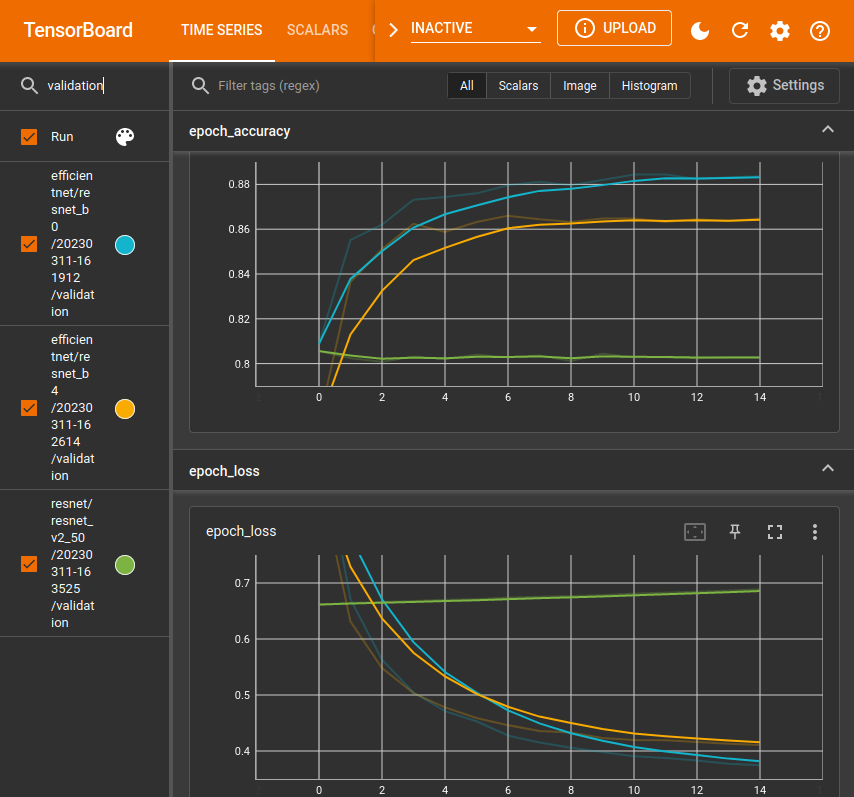
- Tensorflow Transfer Learning
- Feature Extraction
See also:
- Fun, fun, tensors: Tensor Constants, Variables and Attributes, Tensor Indexing, Expanding and Manipulations, Matrix multiplications, Squeeze, One-hot and Numpy
- Tensorflow 2 - Neural Network Regression: Building a Regression Model, Model Evaluation, Model Optimization, Working with a "Real" Dataset, Feature Scaling
- Tensorflow 2 - Neural Network Classification: Non-linear Data and Activation Functions, Model Evaluation and Performance Improvement, Multiclass Classification Problems
- Tensorflow 2 - Convolutional Neural Networks: Binary Image Classification, Multiclass Image Classification
- Tensorflow 2 - Transfer Learning: Feature Extraction, Fine-Tuning, Scaling
- Tensorflow 2 - Unsupervised Learning: Autoencoder Feature Detection, Autoencoder Super-Resolution, Generative Adverserial Networks
Tensorflow Transfer Learning
Transfer Learning leverages a pretrained model that is already extremely performant on general feature detection. Our work will be to re-train this model on our specific dataset and add the specialized knowledge needed to solve our task.
Since the model is already pre-trained we can expect that we will only need about 10% of the amount of data that would be needed to train a fresh model.
Feature Extraction
Download a pre-trained model and set it's layers as un-trainable. The model is able to extract general features. All we need to do is adding a trainable dense layer (or a couple) at the end that we train to recognize our features among the features returned from the base model.
- cd datasets
- wget https://storage.googleapis.com/ztm_tf_course/food_vision/10_food_classes_10_percent.zip
- unzip 10_food_classes_10_percent.zip && rm 10_food_classes_10_percent.zip
tree -L 2
10_food_classes_10_percent
├── test
│ ├── chicken_curry
│ ├── chicken_wings
│ ├── fried_rice
│ ├── grilled_salmon
│ ├── hamburger
│ ├── ice_cream
│ ├── pizza
│ ├── ramen
│ ├── steak
│ └── sushi
└── train
├── chicken_curry
├── chicken_wings
├── fried_rice
├── grilled_salmon
├── hamburger
├── ice_cream
├── pizza
├── ramen
├── steak
└── sushi
Visualizing the Data
import datetime
import itertools
import matplotlib.image as mpimg
import matplotlib.pyplot as plt
import numpy as np
import os
import pandas as pd
import pathlib
import random
import tensorflow as tf
import tensorflow_hub as hub
from tensorflow.keras import Sequential
from tensorflow.keras.layers import Dense, Flatten, Conv2D, MaxPool2D, Activation, Rescaling, RandomFlip, RandomRotation, RandomZoom, RandomContrast, RandomBrightness
from tensorflow.keras.optimizers import Adam
from tensorflow.keras.preprocessing.image import ImageDataGenerator
from tensorflow.keras.utils import image_dataset_from_directory
# check if you have GPU support
tf.config.list_physical_devices('GPU')
# [PhysicalDevice(name='/physical_device:GPU:0', device_type='GPU')]
# physical_devices = tf.config.list_physical_devices('GPU')
# for device in physical_devices:
# tf.config.experimental.set_memory_growth(device, True)
# set directories
training_directory = "../datasets/10_food_classes_10_percent/train/"
testing_directory = "../datasets/10_food_classes_10_percent/test/"
# get class names
data_dir = pathlib.Path(training_directory)
class_names = np.array(sorted([item.name for item in data_dir.glob('*')]))
len(class_names), class_names
# the data set has 10 classes:
# (10,
# array(['chicken_curry', 'chicken_wings', 'fried_rice', 'grilled_salmon',
# 'hamburger', 'ice_cream', 'pizza', 'ramen', 'steak', 'sushi'],
# dtype='<U14'))
# visualizing the dataset
## display random images
def view_random_image(target_dir, target_class):
target_folder = str(target_dir) + "/" + target_class
random_image = random.sample(os.listdir(target_folder), 1)
img = mpimg.imread(target_folder + "/" + random_image[0])
plt.imshow(img)
plt.title(str(target_class) + str(img.shape))
plt.axis("off")
return tf.constant(img)
fig = plt.figure(figsize=(12, 6))
plot1 = fig.add_subplot(1, 2, 1)
plot1.title.set_text(f'Class: {class_names[0]}')
pizza_image = view_random_image(target_dir = training_directory, target_class=class_names[0])
plot2 = fig.add_subplot(1, 2, 2)
plot2.title.set_text(f'Class: {class_names[1]}')
steak_image = view_random_image(target_dir = training_directory, target_class=class_names[1])
fig = plt.figure(figsize=(12, 6))
plot3 = fig.add_subplot(1, 2, 1)
plot3.title.set_text(f'Class: {class_names[2]}')
pizza_image = view_random_image(target_dir = training_directory, target_class=class_names[2])
plot4 = fig.add_subplot(1, 2, 2)
plot4.title.set_text(f'Class: {class_names[3]}')
steak_image = view_random_image(target_dir = training_directory, target_class=class_names[3])
fig = plt.figure(figsize=(12, 6))
plot5 = fig.add_subplot(1, 2, 1)
plot5.title.set_text(f'Class: {class_names[4]}')
pizza_image = view_random_image(target_dir = training_directory, target_class=class_names[4])
plot6 = fig.add_subplot(1, 2, 2)
plot6.title.set_text(f'Class: {class_names[5]}')
steak_image = view_random_image(target_dir = training_directory, target_class=class_names[5])
fig = plt.figure(figsize=(12, 6))
plot7 = fig.add_subplot(1, 2, 1)
plot7.title.set_text(f'Class: {class_names[6]}')
pizza_image = view_random_image(target_dir = training_directory, target_class=class_names[6])
plot8 = fig.add_subplot(1, 2, 2)
plot8.title.set_text(f'Class: {class_names[7]}')
steak_image = view_random_image(target_dir = training_directory, target_class=class_names[7])
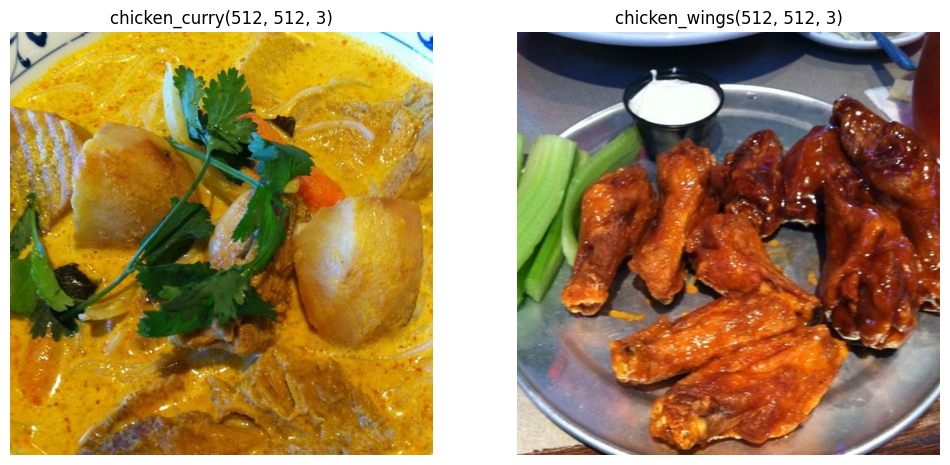
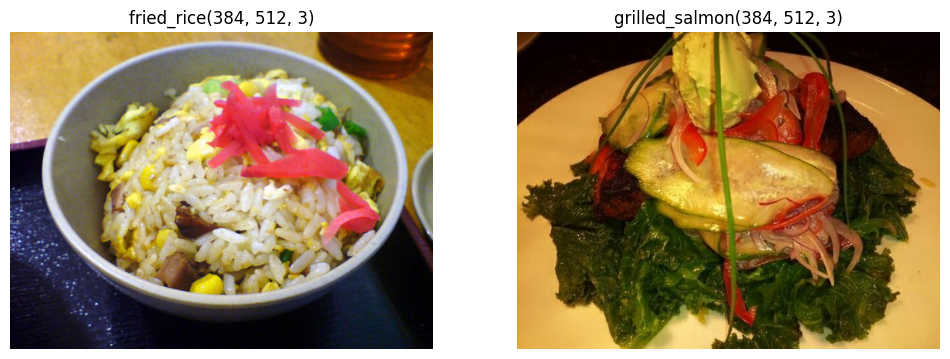
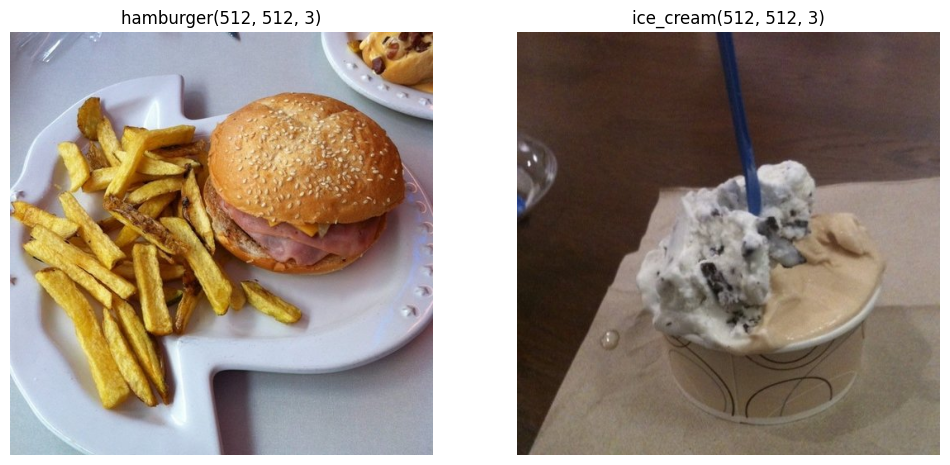
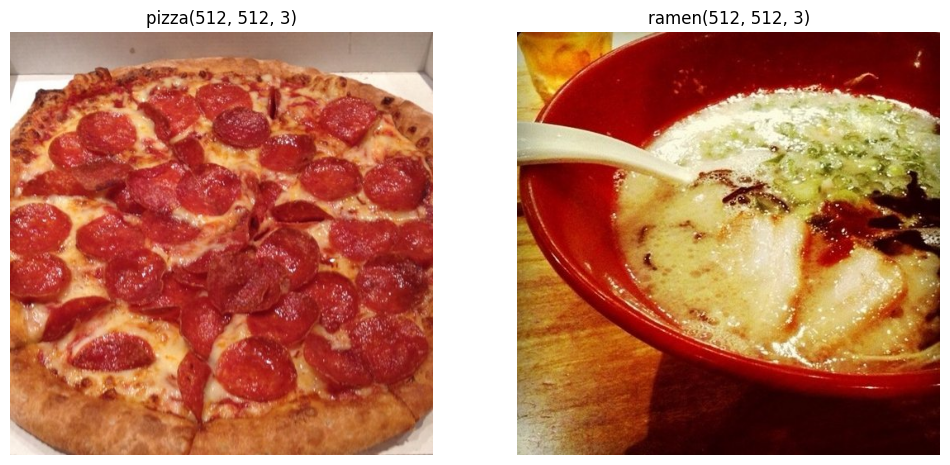
Preprocessing the Data
SEED = 42
BATCH_SIZE = 16
IMG_SHAPE = (224, 224)
training_data = image_dataset_from_directory(training_directory,
labels='inferred',
label_mode='categorical',
seed=SEED,
shuffle=True,
image_size=IMG_SHAPE,
batch_size=BATCH_SIZE)
testing_data = image_dataset_from_directory(testing_directory,
labels='inferred',
label_mode='categorical',
seed=SEED,
shuffle=True,
image_size=IMG_SHAPE,
batch_size=BATCH_SIZE)
# this time we only work with 10% of the training dataset
# Found 750 files belonging to 10 classes.
# Found 2500 files belonging to 10 classes.
TensorBoard Perfomance Tracking
# create a callback to track experiments in TensorBoard
def create_tensorboard_callback(dir_name, experiment_name):
# log progress to log directory
log_dir = dir_name + "/" + experiment_name + "/" + datetime.datetime.now().strftime("%Y%m%d-%H%M%S")
tensorboard_callback = tf.keras.callbacks.TensorBoard(log_dir=log_dir, histogram_freq=1)
print(f"Saving TensorBoard Log to: {log_dir}")
return tensorboard_callback
Building a Model from Tensorflow Hub
Pick a well performing model from the Image Classification Leaderboard and try to find it on:
# model comparison
resnet_model_url = 'https://tfhub.dev/google/imagenet/resnet_v2_50/feature_vector/5'
efficientnet_model_url = 'https://tfhub.dev/tensorflow/efficientnet/b0/feature-vector/1'
# add image augmentations (optional)
# was needed before - but the pre-trained model
# usually does not need huge/augmented datasets
data_augmentation_layer = Sequential([
RandomFlip("horizontal_and_vertical"),
RandomRotation(0.2),
RandomZoom(0.1),
RandomContrast(0.2),
RandomBrightness(0.2)
])
# helper function to create a model
def create_model(model_url, num_classes):
# download pre-trained model as a keras layer
feature_extractor_layer = hub.KerasLayer(model_url,
trainable=False,
name='feature_extractor_layer')
# create sequential model
model = tf.keras.Sequential([
Rescaling(1./255, input_shape=IMG_SHAPE+(3,)),
# data_augmentation_layer,
feature_extractor_layer,
tf.keras.layers.Dense(num_classes, activation='softmax', name='output_layer')
])
return model
Creating a ResNet-based Model
resnet_model = create_model(resnet_model_url, len(class_names))
resnet_model.compile(loss="categorical_crossentropy",
optimizer=Adam(learning_rate=1e-3),
metrics=["accuracy"])
resnet_model.summary()
# Model: "sequential_1"
# _________________________________________________________________
# Layer (type) Output Shape Param #
# =================================================================
# rescaling (Rescaling) (None, 224, 224, 3) 0
# feature_extractor_layer (Ke (None, 2048) 23564800
# rasLayer)
# output_layer (Dense) (None, 10) 20490
# =================================================================
# Total params: 23,585,290
# Trainable params: 20,490
# Non-trainable params: 23,564,800
# _________________________________________________________________
Training the ResNet Model
tf.random.set_seed(SEED)
# fitting the model
history_resnet_model = resnet_model.fit(training_data, epochs=5,
steps_per_epoch=len(training_data),
validation_data=testing_data,
validation_steps=len(testing_data))
# Epoch 5/5
# 15s 325ms/step - loss: 0.2652 - accuracy: 0.9560 - val_loss: 0.6500 - val_accuracy: 0.7836
Creating a EfficientNet-based Model
efficientnet_model = create_model(efficientnet_model_url, len(class_names))
efficientnet_model.compile(loss='categorical_crossentropy',
optimizer=Adam(learning_rate=1e-3),
metrics=['accuracy'])
efficientnet_model.summary()
# Model: "sequential_2"
# _________________________________________________________________
# Layer (type) Output Shape Param #
# =================================================================
# rescaling_1 (Rescaling) (None, 224, 224, 3) 0
# feature_extractor_layer (Ke (None, 1280) 4049564
# rasLayer)
# output_layer (Dense) (None, 10) 12810
# =================================================================
# Total params: 4,062,374
# Trainable params: 12,810
# Non-trainable params: 4,049,564
# _________________________________________________________________
Training the EfficientNet Model
tf.random.set_seed(SEED)
# fitting the model
history_efficientnet_model = efficientnet_model.fit(training_data, epochs=15,
steps_per_epoch=len(training_data),
validation_data=testing_data,
validation_steps=len(testing_data))
# Epoch 15/15
# 11s 228ms/step - loss: 0.1133 - accuracy: 0.9920 - val_loss: 0.3779 - val_accuracy: 0.8828
Comparing both Models
# plotting the loss curves
fig, axes = plt.subplots(nrows=1, ncols=2, figsize=(12, 6))
pd.DataFrame(history_resnet_model.history).plot(ax=axes[0], title="Resnet Model (Multiclass)")
pd.DataFrame(history_efficientnet_model.history).plot(ax=axes[1], title="EfficientNet Model (Multiclass)")
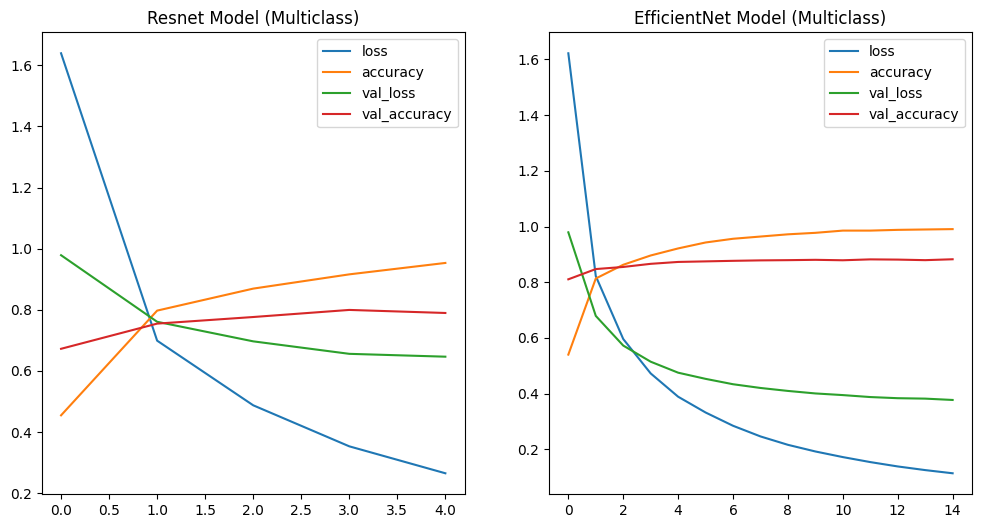
# Plot the validation and training accuracy separately
def plot_accuracy_curves(history1, title1, history2, title2):
accuracy1 = history1.history['accuracy']
val_accuracy1 = history1.history['val_accuracy']
epochs1 = range(len(history1.history['accuracy']))
accuracy2 = history2.history['accuracy']
val_accuracy2 = history2.history['val_accuracy']
epochs2 = range(len(history2.history['accuracy']))
# Plot accuracy
plt.figure(figsize=(12, 12))
plt.subplot(2, 2, 1)
plt.plot(epochs1, accuracy1, label='training_accuracy')
plt.plot(epochs1, val_accuracy1, label='val_accuracy')
plt.title(title1)
plt.xlabel('Epochs')
plt.legend();
plt.subplot(2, 2, 2)
plt.plot(epochs2, accuracy2, label='training_accuracy')
plt.plot(epochs2, val_accuracy2, label='val_accuracy')
plt.title(title2)
plt.xlabel('Epochs')
plt.legend();
# plotting the accuracy curves
plot_accuracy_curves(history1=history_resnet_model,
title1="Resnet Model",
history2=history_efficientnet_model,
title2="EfficientNet Model")
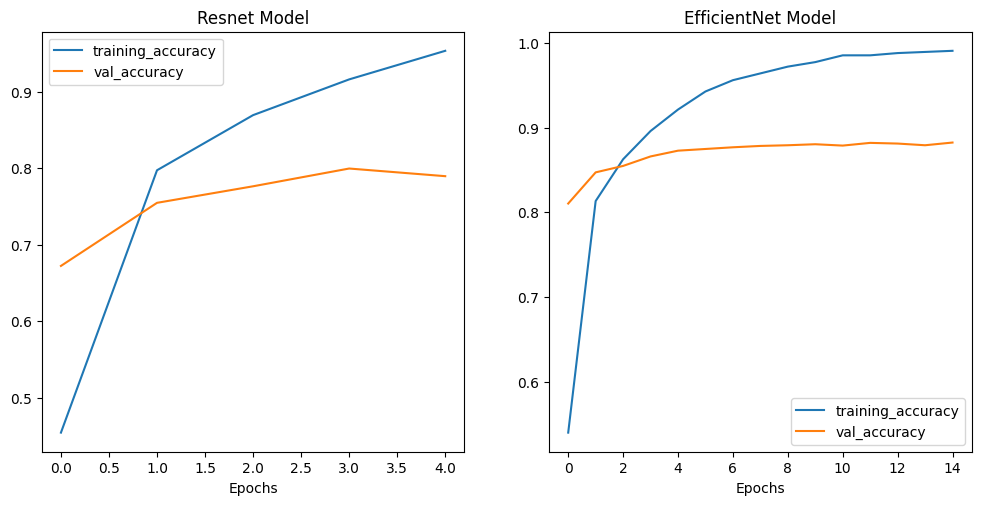
The accuracy of the EfficientNet model is even slightly better than the accuracy of the ResNet Model. There are several EfficientNet models to pick from:
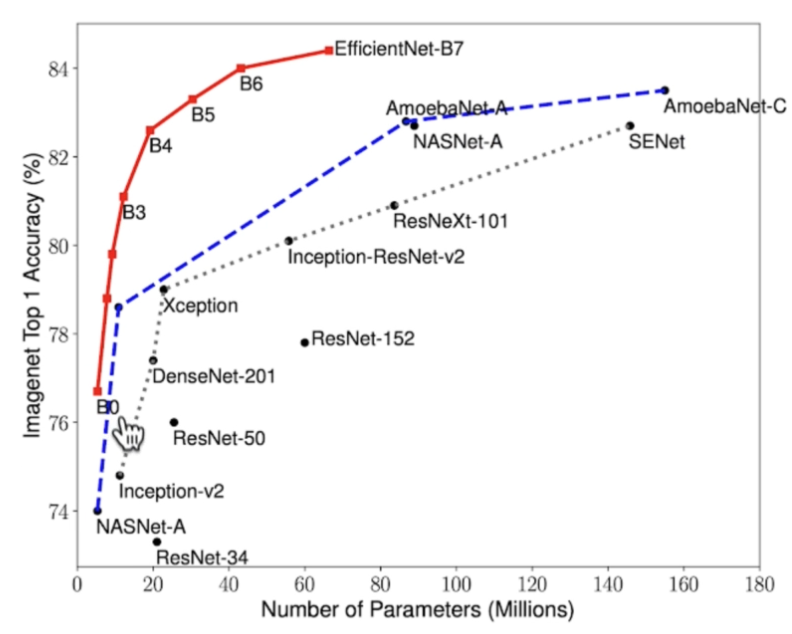
Image source :: EfficientNet: Rethinking Model Scaling for Convolutional Neural Networks
The higher the amount of parameters become the less ressource efficient a training tends to become. The Optimum seems to be around the B4 model.
Using the Tensorboard Callback
ResNetV2 50 vs EfficientNetB0 vs EfficientNetB4
Let's compare the trained B0 model with the B4 (and ResNetv2 50):
EfficientNetB0
# building and training the __EfficientNet B0__ model
efficientnet0_model_url = 'https://tfhub.dev/tensorflow/efficientnet/b0/feature-vector/1'
efficientnet0_model = create_model(efficientnet0_model_url, len(class_names))
efficientnet0_model.compile(loss='categorical_crossentropy',
optimizer=Adam(learning_rate=1e-3),
metrics=['accuracy'])
tf.random.set_seed(SEED)
# fitting the model
history_efficientnet0_model = efficientnet0_model.fit(training_data, epochs=15,
callbacks=create_tensorboard_callback(dir_name='../tensorboard/efficientnet',
experiment_name='resnet_b0'),
steps_per_epoch=len(training_data),
validation_data=testing_data,
validation_steps=len(testing_data))
# Epoch 15/15
# 13s 284ms/step - loss: 0.1126 - accuracy: 0.9920 - val_loss: 0.3746 - val_accuracy: 0.8836
EfficientNetB4
# building and training the __EfficientNet B4__ model
efficientnet4_model_url = 'https://tfhub.dev/tensorflow/efficientnet/b4/feature-vector/1'
efficientnet4_model = create_model(efficientnet4_model_url, len(class_names))
efficientnet4_model.compile(loss='categorical_crossentropy',
optimizer=Adam(learning_rate=1e-3),
metrics=['accuracy'])
tf.random.set_seed(SEED)
# fitting the model
history_efficientnet4_model = efficientnet4_model.fit(training_data, epochs=15,
callbacks=create_tensorboard_callback(dir_name='../tensorboard/efficientnet',
experiment_name='resnet_b4'),
steps_per_epoch=len(training_data),
validation_data=testing_data,
validation_steps=len(testing_data))
# Epoch 15/15
# 33s 711ms/step - loss: 0.1176 - accuracy: 0.9893 - val_loss: 0.4109 - val_accuracy: 0.8648
ResNetv2 50
# building and training the __ResNetv2 50__ model
resnet2_50_model_url = 'https://tfhub.dev/google/imagenet/resnet_v2_50/feature_vector/5'
resnet2_50_model = create_model(resnet2_50_model_url, len(class_names))
resnet2_50_model.compile(loss="categorical_crossentropy",
optimizer=Adam(learning_rate=1e-3),
metrics=["accuracy"])
tf.random.set_seed(SEED)
# re-running the resnet training
history_resnet_model = resnet_model.fit(training_data, epochs=15,
callbacks=create_tensorboard_callback(dir_name='../tensorboard/resnet',
experiment_name='resnet_v2_50'),
steps_per_epoch=len(training_data),
validation_data=testing_data,
validation_steps=len(testing_data))
# Epoch 15/15
# 19s 405ms/step - loss: 0.0056 - accuracy: 1.0000 - val_loss: 0.6888 - val_accuracy: 0.8028
efficientnet0_model.summary()
# Model: "sequential_3"
# _________________________________________________________________
# Layer (type) Output Shape Param #
# =================================================================
# rescaling_2 (Rescaling) (None, 224, 224, 3) 0
# feature_extractor_layer (Ke (None, 1280) 4049564
# rasLayer)
# output_layer (Dense) (None, 10) 12810
# =================================================================
# Total params: 4,062,374
# Trainable params: 12,810
# Non-trainable params: 4,049,564
# _________________________________________________________________
efficientnet4_model.summary()
# Model: "sequential_4"
# _________________________________________________________________
# Layer (type) Output Shape Param #
# =================================================================
# rescaling_3 (Rescaling) (None, 224, 224, 3) 0
# feature_extractor_layer (Ke (None, 1792) 17673816
# rasLayer)
# output_layer (Dense) (None, 10) 17930
# =================================================================
# Total params: 17,691,746
# Trainable params: 17,930
# Non-trainable params: 17,673,816
# _________________________________________________________________
resnet2_50_model.summary()
# Model: "sequential_5"
# _________________________________________________________________
# Layer (type) Output Shape Param #
# =================================================================
# rescaling_4 (Rescaling) (None, 224, 224, 3) 0
# feature_extractor_layer (Ke (None, 2048) 23564800
# rasLayer)
# output_layer (Dense) (None, 10) 20490
# =================================================================
# Total params: 23,585,290
# Trainable params: 20,490
# Non-trainable params: 23,564,800
# _________________________________________________________________
Summary
- EfficientNetB0
- Trainable params: 12,810
- Non-trainable params: 4,049,564
- Training time per epoch: 13s
- Results (15 epochs): val_loss: 0.3746 - val_accuracy: 0.8836
- EfficientNetB4
- Trainable params: 17,930
- Non-trainable params: 17,673,816
- Training time per epoch: 33s
- Results (15 epochs): val_loss: 0.4109 - val_accuracy: 0.8648
- ResNet50 v2
- Trainable params: 20,490
- Non-trainable params: 23,564,800
- Training time per epoch: 19s
- Results (15 epochs): val_loss: 0.6888 - val_accuracy: 0.8028
# Load TensorBoard
%load_ext tensorboard
%tensorboard --logdir '../tensorboard/'
